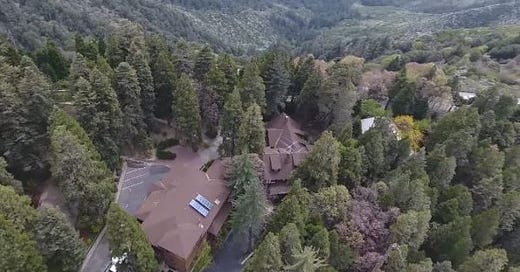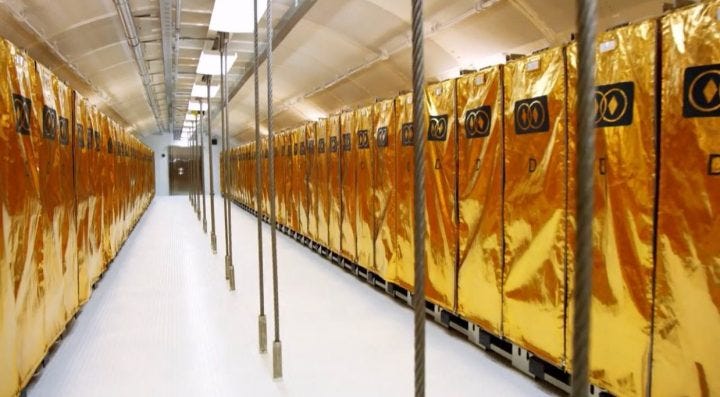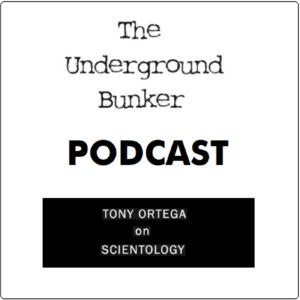Bruce Hines has another terrific narrative for us, this time about his trip to a place very few people in Scientology ever got to visit. It’s a small compound in the San Bernardino Mountains where, years after Bruce’s visit, Shelly Miscavige was sent in 2005. We believe she is still there today, being kept out of sight for the past 17 years.
It was a bit like going into a submarine. I admit I have never been in or on one, but it is how I imagine it to be. I climbed down a ladder into a very large, metallic cylinder. Inside, it was well lit. I stood on a platform that ran the length of the tube, which was at least 50 feet long, probably more, maybe 10 or 12 feet in diameter, with plenty of headroom for me.
I was at the headquarters of the Church of Spiritual Technology, or CST, or, more commonly, it was referred to as “Archives.” That is a pretty strange name for a “church.” For me the name “Church of Spiritual Technology” conjures images of seances, eerie music, and electronic screens with flashing lights in a 1950s movie. Actually it was part of Scientology’s complicated international network. It was made up of Sea Organization members. Interestingly, for several years relatively few Sea Org people knew of its existence, and fewer still knew where it was located nor much about its purpose.
It was located in the mountains just north of San Bernardino, California. Two towns that are nearby are Crestline and Twin Peaks. I was driven there by a guy named Rich Gilbert. He was CST staff and came to the Int Base near Hemet to pick me up. The CST people were some of the relatively few Sea Org members who had the necessary security clearances to go to Int. This was in the early 90s. I rode along in a Honda, probably a Civic, which was one of the CST staff cars. I enjoyed the scenery, especially as we got up into the higher mountains along very winding roads, similar to ones I was familiar with in Colorado. There were some nice panoramas of parts of the Inland Empire along the way.
I had known Rich and his wife, Linda, since 1978, when he worked at the Westwood Mission in LA at the same time as my sister. At the time I was working as an electrician for my brother-in-law, Joe Duncanson. After I went into the Sea Org, Rich went to work for Joe and eventually became a partner in his electrical contracting business. They were very successful — so much so that they, their wives, plus a third partner named Evan Malm and his wife, all paid their way up the Bridge to “New OT VIII,” which was (and still is) as high as one could go. The auditing hours alone that they had to purchase for six people cost a huge amount of money. I’ve heard of estimates of around $300,000 for a person to go from the bottom to the top of the Grade Chart. The amount varies from person to person, since some people complete auditing actions in fewer hours than others.
Regardless, they had to pay huge amounts. Add to that the cost of multiple trips to Clearwater and to the Sea Org ship for all of them, including flights, accommodations, food, and arrangements for getting their kids looked after. They had a good setup. When one had to go off to get some auditing the others could cover their work. Also, when one had to audit oneself at home on “Solo NOTs” the time to do so could be much more easily arranged. A person on Home Solo NOTs is expected to give themselves at least a few sessions every day.
Anyway, after those six people had made it to the top of the Bridge, they started looking at other ways to be involved in Scientology. This included the option of joining the Sea Org. I know my sister was pretty serious about it. That would be a big life-style change for those people, as they were all pretty well-off financially. For example, a couple would have to move from a large, comfortable house into a small room with just a bed and little other furniture. They would be separated from their children, excepting brief visit periods.
There was a problem with that idea though. They had taken LSD prior to getting involved in Scientology. There was express policy from founder L. Ron Hubbard, in the form of a “Flag Order,” which forbade an LSD-taker from joining the Sea Org. I know that many public Scientologists would use that as an out when talking to Sea Org recruiters, who can be incredibly persistent. “Sorry, I can’t join, I took LSD.” Even taking it once was enough to disqualify someone. Recruiters usually responded by saying, “Are you sure it was LSD and not something else like mescaline or psylocybin? Did someone give you something they said was LSD when it actually wasn’t?” The recruiters would even make up lists of the effects of various drugs to try to establish whether the person really experienced the things that LSD produces.
Around that time there was a new “pilot project” being run at Archives. The idea was to allow LSD-takers to join the Sea Org, if they were otherwise qualified and passed security clearances, and to be posted at the Crestline facility of CST. And then see how they did. I don’t know who was behind this project, but I can’t imagine it would have happened without David Miscavige’s approval. But why at CST and not some other Sea Org facility? All I can think of is that it was a relatively small organization that was isolated from other Sea Org units. On the other hand, you wouldn’t want these LSD-people messing up the important work, in the eyes of top management, that CST was doing. Hubbard thought that LSD made people incapable.
There are Sea Org members who had taken LSD before the policy prohibiting it was issued in 1979. One such person was Ray Mithoff, who was a huge Grateful Dead fan before getting involved in Scientology. A lot of people who got converted to Scientology had been college students in the late 60s and early 70s, where the use of psychedelic drugs was pretty common. I don’t know the details, but in the end Rich and Linda Gilbert did join the Sea Org, while my sister, her husband, Evan Malm, and his wife did not. My recollection is that there was at least one other person, Midge Hunt, who was an LSD-taker and joined the Sea Org at CST as part of that pilot project.
It was a bit surreal that Rich, whom I had known for years and who had close ties with my family, was driving me to the CST headquarters. It is about an hour’s drive from Int to Twin Peaks. I was looking forward to seeing the place. I didn’t know what to expect. I had heard of it and knew that relatively few people had ever been there. We arrived on a narrow road, CA-189, and drove into the property through a security gate. We were in the middle of an evergreen forest. There were trees everywhere with buildings, none of them very big, scattered here and there. It struck me as being very green, especially compared to the terrain around the Int Base. I don’t remember exactly, but there were maybe 20 buildings on the property, which covered a few hilly acres. The buildings were log-cabin-like. It was a whole different vibe compared to Int.
Rich gave me a brief tour of the property and its various activities. I don’t remember a lot about that. One thing was that they had some very large audio tape machines called Studers, which were just like ones in Gold. Those were used to produce tape cassettes, reel-to-reel tapes, and CDs from a master tape, if I recall correctly. There was also lots of other equipment used to accomplish CST’s purpose: to put all of Mr. Hubbard’s writings and spoken words into a very long-lasting and nearly indestructible form. The written words were to be etched onto metal plates (stainless steel, I think), the spoken words were to be recorded on special, high-tech CDs, and all of it was to be placed in sealed titanium capsules. The capsules then were to get stored in underground vaults.
Why go to all that trouble? Well, Scientologists believe that the words of Hubbard are so valuable, making possible the only salvation of mankind, that they should be preserved for thousands of years. Potentially, they might be discovered by future generations, after an apocalypse or something, to rebuild civilization the right way. I can imagine some poor person trying to make sense of it from scratch in some future time. Good luck! Also, since CST started on this huge task, Hubbard’s writings and recorded lectures have been often revised. Do the steel plates and CDs then have to get switched out?
Like all Scientology organizations, which are set up in a particular pattern as laid out by Hubbard, it had a Qualifications Division (usually referred to as Qual) — the part that is supposed to make sure that the products delivered by the organization were of sufficient quality. At least that is the theory of it. One of Qual’s functions was to train, audit, and correct the staff of the org. At that time, that division of CST at the Crestline facility had a couple of auditors, a case supervisor (responsible for overseeing the auditing), a course supervisor, and a cramming officer (who got staff to re-study things they had been trained on after they had made some kind of mistake). But because CST was so isolated from the rest of the Scientology world, these people in Qual had been operating without any oversight. I got an order that I should go there, inspect the auditing and training records, and correct things found to be wrong. The order came to me because at the Int Base that had been my job as the Technical Correction Director International.
Rich’s tour included seeing the submarine-like structure, mentioned above. This was one of the vaults. It was still under construction. It was buried in the ground, but still partially exposed at that time. It was designed to withstand harsh conditions. I climbed through a hatch and down a ladder, looking around in some amazement. It was big. It was somewhat like an old-time file room, except the shelves did not hold boxes with paper in them. They were to hold the titanium capsules.
After the tour I went about my business of looking at auditing folders and student files, and interviewing the Qual staff. During that time we had lunch in their cafeteria (mess hall) and later ate dinner. I found that they had been doing pretty much what they were supposed to. The problem with that kind of inspection is that if one of the executives of CST got in trouble later, meaning if Miscavige got mad about something, it would be assumed that errors had been made in their auditing and training. And then I could have gotten trouble for having missed those errors. Luckily, that didn’t happen.
Rich then drove me back to the Int Base in the evening. Some time later I ended up spending a lot of time with Rich on the RPF (the Sea Org’s prison program) and on the RPF’s RPF. We were even “RPF twins” for a while. We did a lot of manual labor together. In 2001 when the RPF at Int was disbanded (because of a lot of bad publicity about it), Rich got put on a post in Gold. I got sent to New York City, supposedly to work on the renovation of the premiere building there, half a block from Times Square. The last I knew, Rich was still in Gold.
His wife, Linda, also ended up in Gold, though she didn’t spend time in the RPF. I don’t know what happened to Midge Hunt. I don’t believe anything became of that LSD pilot project. The last I knew, one still could not join the Sea Org if they had taken LSD. The way that CST was structured, passers-by or curious persons could not see in. The staff could go about their work without prying eyes. It is situated on a hill with fairly rugged terrain, surrounded by tall fences, many of which had razor wire or ultrabarrier strung along the top. The buildings where sensitive work was going on were in the interior area of the property with large trees around them, not visible from the outside.
That is, until someone got the idea to fly a drone with a high-resolution camera over it. Now that there is a good chance that Shelly Miscavige is interned there, I imagine the security measures are even more extreme.
— Bruce Hines
Thank you for reading today’s story here at Substack. For the full picture of what’s happening today in the world of Scientology, please join the conversation at tonyortega.org, where we’ve been reporting daily on David Miscavige’s cabal since 2012. There you’ll find additional stories, and our popular regular daily features:
Source Code: Actual things founder L. Ron Hubbard said on this date in history
Avast, Ye Mateys: Snapshots from Scientology’s years at sea
Overheard in the Freezone: Indie Hubbardism, one thought at a time
Past is Prologue: From this week in history at alt.religion.scientology
Random Howdy: Your daily dose of the Captain
Here’s the link for today’s post at tonyortega.org
And whatever you do, subscribe to this Substack so you get our breaking stories and daily features right to your email inbox every morning…
Now available: Bonus for our supporters
Episode 8 of the Underground Bunker podcast has been sent out to paid subscribers, and it’s a conversation with Patty Moher about her amazing career as a Scientology spy and then her years leaking great info about the church. Meanwhile, we’ve made episodes 1 through 7 available to everyone, with Geoff Levin on Scientology’s celebrities, Pete Griffiths on running a mission, Sunny Pereira dishing secrets of Scientology’s Hollywood Celebrity Centre, Bruce Hines on the crazy life in the Sea Org, Jeffrey Augustine on recent Scientology court cases, Claire Headley exposing Tom Cruise, and Marc Headley on what it must be like for David Miscavige living in Clearwater, Florida. Go here to get the episodes!






Thank you Bruce, your info on the pleasant gulag is welcome. I do have to wonder how many 'outside security officers' are watching the place and who has to keep Shelly in line and 'in production'. How close to solitary confinement is that place? I don't think anyone outside of Twin Peaks will ever see Shelly Miscavige again.
The longer I am out of scientology, the more insane the vaults seem, especially since all those stray semicolons keep sneaking in and LRH’s unaltered make believe “tech” gets altered once again. His original recordings probably do not even exist because they would contradict what is now considered standard tech, so the farce of preserving them is cuckoo for Cocoa Puffs.